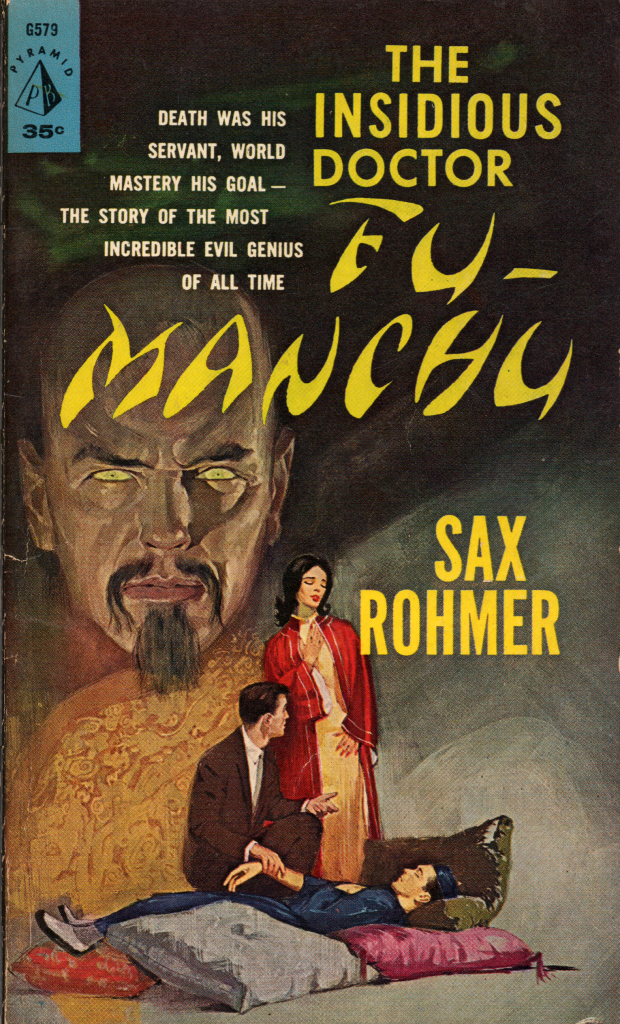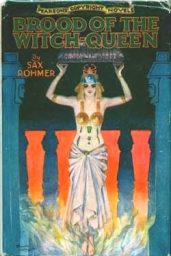The Pulp One-Hit Wonder: Sax Rohmer
Saturday , 22, April 2017 Authors, Before the Big Three, Book Review, Fiction 14 CommentsAt first glance, it seems strange that Arthur Henry Ward, writing under the pseudonym Sax Rohmer, doesn’t garner more attention on this blog. After all, he wrote the enormously entertaining, successful, and influential The Insidious Dr.Fu-Manchu.
But upon further reflection, it makes sense. The book in question is not fantasy or science fiction. And as we will see, it was likely Rohmer’s only significant work. His fantasy tales aren’t better known for a reason.

Rohmer has much in common with many other writers of weird fiction. Born to a working-class family in Birmingham, England, in 1883, he worked a series of odd jobs before becoming a writer, much like Edgar Rice Burroughs. Along with fellow writer Algernon Blackwood, he was a member of the occult organization The Golden Dawn. This is reflected in his work; Rohmer’s descriptions often have a dream-like and sumptuous quality to them, as Blackwood’s The Willows does. And Rohmer was eternally fascinated with the exotic, whether Oriental or Egyptian.
Rohmer attained success at the same time Burroughs did, with the serialization of The Insidious Dr.Fu-Manchu from 1912 to 1913. The subsequent publication was a smash success and adapted into films dozens of times.
And it really is a damn good book! Reading it at the age of 14, I had never come across a novel this purely exciting, with its full-blooded adventure and breakneck pacing surpassing many of my favorite action films. In the first few pages, there is a bizarre murder and an introduction to Denis Nayland Smith, a brilliant, tough, thoroughly English detective exemplifying the very best of that race. He is assisted by faithful sidekick Dr. Petrie, who hears Smith’s shocking story with stoicism and vows to help, no matter the risks.
And this is where we are first told about the title villain, Dr. Fu-Manchu, a diabolical, thoroughly evil genius. His schemes are always shadowy, but assuming they involve anything less than world domination would be a mistake and an insult.
The comparisons to Holmes and Dr. Watson are obvious, but Smith and Dr. Petrie stand on their own. And Dr. Fu-Manchu, much as I love Conan Doyle’s books, is superior to Professor Moriarty. There is another wrinkle that the Holmes mysteries lacked; a seductive, beautiful woman. A slave of Dr. Fu-Manchu, Kâramanèh is an exotic Egyptian who falls in love with Dr. Petrie, aiding our duo in their desperate struggle. She is one of the sexier pulp heroines I’ve come across, who, as a double agent, remains an enigma throughout the novel.
 The book follows an episodic format, with each chapter featuring a new outrage Smith and Dr. Petrie must investigate. All leading to the Chinese master villain himself. One never knows where he will strike next! Or what ingenuous method of death he will employ, whether rare poisons, ninjas that blend into the night, and other oddities that make the crime undecipherable for the British authorities.
The book follows an episodic format, with each chapter featuring a new outrage Smith and Dr. Petrie must investigate. All leading to the Chinese master villain himself. One never knows where he will strike next! Or what ingenuous method of death he will employ, whether rare poisons, ninjas that blend into the night, and other oddities that make the crime undecipherable for the British authorities.
It’s a consistently thrilling, action-packed novel that never slows down, and manages to come up with a fresh, unique mystery each chapter. Not to mention weave a larger narrative through the episodes themselves, no mean feat, culminating in a suitably grand, picturesque finale. It’s one of the best pulp works I’ve read, and one I would recommend everyone here try.
Critics will contend that it’s “racist” towards the Chinese. I’m sure Castalia House readers will consider that a point in the book’s favor, as all the very best novels and movies are accused of an egregious “-ism” by modern leftists.
As a teen, I even thought it was complementary towards the Chinese to portray them as so brilliant and powerful. I wanted to be an evil genius, too!
But it’s important to note that Dr. Fu-Manchu is not working solely for himself, but aiding the power and influence of his native land. This was called alarmist, with Fu-Manchu an example of Yellow Peril.
Yet, it is curious to note that when it was published in 1913, the British Empire was one of the most powerful nations on Earth, while China was a populous but weak country dominated by Japan. 104 years later, Britain is a second-rate power and China is arguably the most powerful nation on Earth, influencing countries on every major continent, including Africa.
Sadly, The Insidious Dr.Fu-Manchu was easily Rohmer’s peak. I’ve read the sequel, The Return of Dr.Fu-Manchu, only to be disappointed. It’s a retread of the original, following the same format, only the mysteries are duller, the excitement lacking, and even Fu-Manchu himself is a more ordinary, occasionally foolish fellow. Every once in a while, it catches glimmers of the original’s phenomenal blend of mystery and adventure, but no more. This installment ends with a whimper instead of a bang.
Rohmer wrote one more Fu-Manchu work and wished to be done with it. Sadly, financial problems led him to return to the series 14 years later, with 1931’s Daughter of Dr.Fu-Manchu. I can’t imagine they were any good. By the last, 13th book, Emperor Fu-Manchu, affairs had become so ridiculous that Smith and Dr. Petrie were allies with the wicked doctor eternally trying to torture and kill them.

Sadly, the cover is more exciting than the book itself.
I also tried reading another Rohmer pulp work, the fantasy Brood of the Witch Queen. I might well review it on here, under the title “How NOT to Write Pulp”. Of all the pulp novels I’ve come across, ranging from terrible to excellent, this is the worst. Every single blunder and weakness of the genre is present in this book. It is sloppy and lazy in every regard, unable to even maintain a coherent narrative between its episodic chapters, with later installments contradicting earlier ones.
It was difficult for me to believe that the author of one of the best pulp works, The Insidious Dr.Fu-Manchu, could have written one of its worst just five years later!
Nevertheless, while Rohmer may have been a one-hit wonder, that is far more than most authors ever achieve. Better to have one great, memorable work than dozens of middling ones. The great science fiction writer and pulp enthusiast Philip José Farmer included Nayland Smith among Tarzan, Doc Savage, Professor Challenger, The Shadow, and others in his Wold Newton family. The iconic villain has become an established symbol of popular culture. And The Insidious Dr.Fu-Manchu retains the power to thrill and delight to this day.
I’ve actually read almost all of Rohmer’s Fu Manchu books over the years, and all but the first are so forgettable that the only thing I can remember about them is that Petrie’s daughter gets kidnapped by the arch villain at one point.
I’ve never even heard of Brood of the Witch Queen.
But that first book is amazing.
I guess we’ll have to agree to disagree. I’ll take BROOD OF THE WITCH-QUEEN over quite a few other Rohmer novels, including many of the Fu Manchus.
Rohmer wasn’t quite a one-hit wonder with Fu Manchu. There was a market for about 10 novels featuring Sumuru and Gaston Max:
http://www.njedge.net/~knapp/FuFrames.htm
It is given to very few writers to create more than one iconic literary character. Rohmer sold new, non-Fu Manchu novels pretty steadily for decades, but Fu Manchu was the obvious standout.
Rohmer’s influence is vast. It is likely that his novel, BAT-WING, was an influence on “The Call of Cthulhu”. Ian Fleming was a Rohmer fan, as was Karl Edward Wagner. Robert E. Howard named Sax as one of his favorite writers and the examples of Rohmer’s influence on REH’s writing goes far beyond “Skull-Face”.
Regarding Rohmer’s “racism”… As William Patrick Maynard and others have pointed out, Fu Manchu was the smartest — and oftimes most honorable — man standing in any given room. He was the smartest man on the planet, basically…and that includes all the white men. The horror. The utter, racist horror of it all.
9 out of 10 writers back then were in The Golden Dawn! Though, seems like it was really little more than just another social club for most of them (obviously, folks like Machen or Blackwood were seriously into occult).
Anyway, “The Insidious Dr. Fu-Manchu” and “Bat Wing” are both available as (pretty professionally read) Librivox recordings. I’ve never read anything else from his gigantic output, so I really cannot comment on whether it is ignored for a reason or not.
When I describe the Fu Manchu books to people, I usually frame them in terms of horror movie franchises. You don’t watch Nightmare on Elm Street because you’re so involved with the kids getting killed off; you watch because of Freddy. Fu Manchu is the draw, not Smith and Petrie, who are likable enough but kind of drab (certainly no Holmes and Watson).
As for the yellow peril, well, what are our relations with China like these days? Rohmer may have gotten the details wrong, and I’m sure he was making up a lot of stuff for the sake of his stories, but…
-
Rohmer was off to a small degree. When he invented Fu Manchu, there was already a vast Oriental organization committed to global domination and subversion of the West: the Empire of Japan.
Rohmer and many others recognized the vast latent power in China’s huge population and resources. I think many assumed China would out-Japan Japan at a much faster pace than actually happened. Just because the timeline was off by a century doesn’t negate the basic soundness of the assessment. It would be hard — at the time — to figure in just how much the rise/imposition of Marxism throughout Asia would skew things.
For those not thoroughly dissuaded from giving BROOD OF THE WITCH-QUEEN a try, here’s a good etext:
https://en.wikisource.org/wiki/Brood_of_the_Witch_Queen
Just look at the chapter titles: “The Ring of Thoth”, “The Secret of Dhoon”, “The Mask of Set”, “The Scorpion Wind”, “Flowering of the Lotus”, “The Wizard’s Den”. Do they not whisper of Stygia and Thoth-Amon? The book was written in 1918, 14yrs before the first Conan yarn.
Read this passage and try not to think of Akivasha and Conan and the pyramids of Khemi:
“Her pale face formed a perfect oval; the long almond eyes had an evil beauty which seemed to chill; and the brilliantly red mouth was curved in a smile which must have made any man forget the evil in the eyes. But when we move in a dream world, our emotions become dreamlike too. She placed a sandalled foot upon the mud floor and stepped out of the sarcophagus, advancing towards Dr. Cairn, a vision of such sinful loveliness as he could never have conceived in his waking moments. In that strange dream language, in a tongue not of East nor West, she spoke; and her silvern voice had something of the tone of those Egyptian pipes whose dree fills the nights upon the Upper Nile—the seductive music of remote and splendid wickedness”
To me, that’s not bad writing, though YMMV. Now, don’t think for a moment that I believe Rohmer to be a crafter of timeless prose. I don’t. To me, he has always been far better at the “imagination” end of things than he was at execution. Still, there is much to be said for imagination. If all you want is technically perfect — but boring — prose, characterization and plotting, go read some Steinbeck or Updike. Rohmer blew some peoples’ minds — REH, Fleming and Wagner included. Without Rohmer, we wouldn’t have much of the sinister background we find in the Conan yarns or James Bond or R’as al-Ghul or Wagner’s Kane. There’s something to be said for that.
Thank goodness I’m not the first one to mention REH’s Skull-face! The impact of that story upon me was very great, and for years I was haunted by visions of opium dens on the foggy docks of London, sinister plots against civilization, the Super Soldier-Slave serum, exotic Zuleika, and quite liked the trick of making Kathulos a not-quite-Chinaman.
And yes, REH wrote rings around Rohmer—and I liked Rohmer.
I like the way Skull-face links Holmes and Watson, Rohmer’s “play up the villain” flip-the-script approach AND Lovecraft.